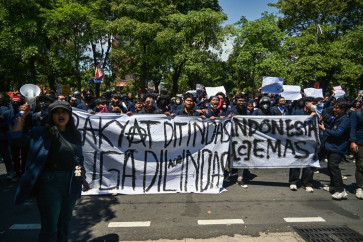Popular Reads
Top Results
Can't find what you're looking for?
View all search resultsPopular Reads
Top Results
Can't find what you're looking for?
View all search resultsIndonesia to exceed coal output on favorable weather
Indonesia, the world’s biggest exporter of thermal coal, expects to exceed production targets for this year by up to 8 percent due to a mild El Nino and dry weather that will help to optimize the extraction rate
Change text size
Gift Premium Articles
to Anyone
I
ndonesia, the world’s biggest exporter of thermal coal, expects to exceed production targets for this year by up to 8 percent due to a mild El Nino and dry weather that will help to optimize the extraction rate.
Bambang Gatot Ariyono, director for coal and minerals utilization at the energy and mineral resources ministry, told reporters Wednesday that drought, alongside a milder El Nino effect, would help producers exceed this year’s 250 million ton coal production target.
The Meteorology, Geophysics and Climatology Agency (BMG) said Indonesia would experience dry weather starting from May to July. The weather will also affect the coal-rich island of Kalimantan.
“Some coal producers have increased their production target,” said Bambang. He declined to specify the expected percentage increase in production, since a clearer estimate could only be made later.
Bob Kamandanu, chairman of the Indonesian Coal Mining Association (APBI), a business association representing 45 coal companies, firmly stated that coal production could rise by up to 8 percent.
“The production increase has been expected. The dry weather will help boost production,” he said.
The increase in production, he added, was also a response to forecasts on global coal demand, expected to grow in line with the global recovery from economic downturn.
The Bank of America Merrill Lynch Global Report on energy for 2010 forecasts that the global thermal coal market will firmly rebalance primarily from the demand side. It expects demand in the Pacific region to outstrip that of the West.
A combination of industrial demand recovery, growth in coal-fired power generation and fuel switching from fuel oil will support global coal demand next year at around 3 percent growth, up from -0.3 percent in 2009, the report shows.
Looking at the main demand drivers in turn, demand in China and India is growing rapidly, driven by the upsurge in electricity generation and strategic stock-building.
China has been moving away from Australia and Indonesia, at the margin, starting to source coal from more distant places like Russia, South Africa, Canada and Colombia — helped by low freight rates.
In India, an acute shortage of domestic coal and a string of supply constraints have driven coal imports sharply higher. With domestic demand for coal likely to grow unabated, Indian companies are buying up coal assets in South Africa, Indonesia and Australia.
The government records that there are 76 coal companies holding Coal Contracts of Works (CCoW), locally known as PKP2B, and estimates there are 8,000 coal companies holding mining rights, locally known as Kuasa Pertambangan (KP).
Also on Wednesday, Bambang reminded miners to convert their old mining contracts to the new form of mining licenses (IUP) as stipulated by the new mining law. He said the miners must obtain the IUPs by April at the latest.
“All miners must adjust their old mining contracts to be IUPs by April at the latest otherwise their working areas cannot be included in the country’s spatial planning,” Bambang said.










